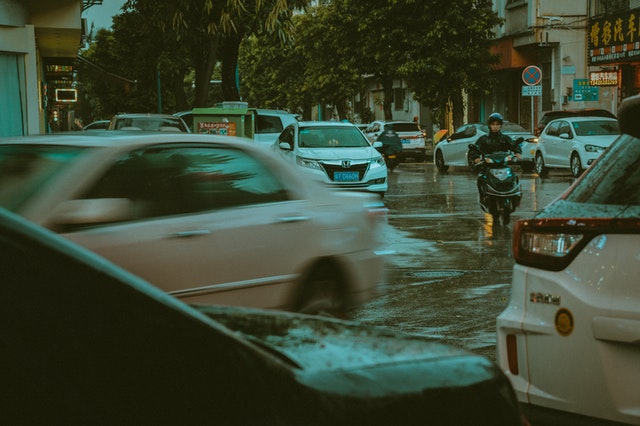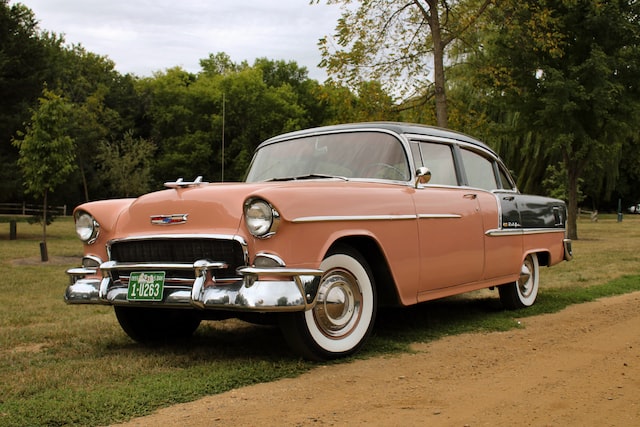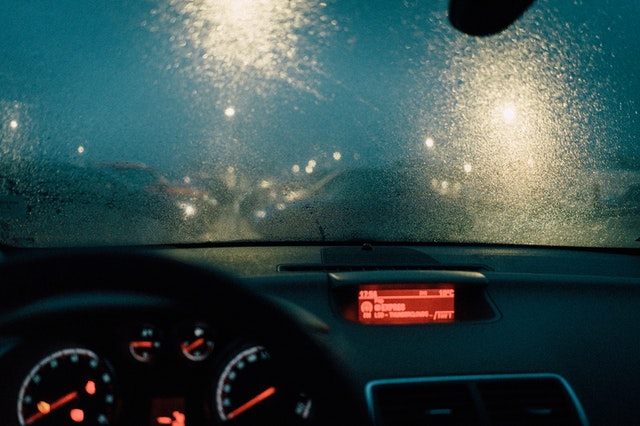When driving in the rain, drivers often face many risks such as reduced visibility, flooded roads, slippery roads, or fallen trees. It is very important to equip yourself with the knowledge to deal with situations that occur when traveling in rainstorms. To ensure more safety for yourself, those around you, and your own vehicle, pocket the experiences of holding the steering wheel in the rain in this article.

Risks of driving in the rain
Driving on flooded roads encounters many traffic obstacles and damages vehicle systems. Here are the possible harms your car may experience:
- Electrical system short
Rainwater is also a conductor, so when water enters the electrical system (motors, horns, sensors) and electronic control boxes, airbags, ABS, etc., it will be damaged by touch, short and oxidize electronic components.
- Damage to the chassis system
When rainwater penetrates into the underbody system, it will rust, damage, and reduce the lubrication and elasticity of the system. From there, your car is at greater risk of damage, and the life of the vehicle is also significantly reduced.
- Reduced effectiveness of clutch and brake
Water entering the clutch and brake will reduce the friction of the friction discs, clutch pads… reducing the performance and safety of the vehicle. Wet interior: Rainwater entering the car interior if left for a long time will cause mold and odor.
- Engine failure
Water enters the engine through the engine air intake. When the engine is operating normally, the pistons move up to compress the intake air mixture at a very high speed, because the intake air mixture has been displaced by water and because the water is not compressed, it is this pressure that creates a jet. damage the engine. Lightness will bend the arm, reducing engine power. Severe, broken arm, broken engine.
- Danger to the driver
The most notable risk is the danger to the driver himself when driving in the rain. When it rains, you may find it difficult to control the steering wheel (especially for inexperienced drivers), thereby having a high chance of taking a long-distance accident. In case you have never had experience driving in the rain, it is better to find a shelter until the rain stops.
How to drive in the rain?

When driving in the rain or when driving on wet roads you should follow these tips for driving in the rain to ensure your safety yourself as well as others.
- Check the safety system
Before starting your journey on a rainy day, make sure that your car’s brakes, lights, and wipers are working properly. You should replace your wiper pads or wipers at least once a year. New tires should be changed every 40,000 – 50,000 km. Besides, you also need to pay attention to the tire pressure that must meet the technical specifications.
- Go slowly when encountering slippery, flooded roads
When traveling in the rain, you should equip yourself with information about flooded areas, low-lying areas, so that when traveling, you must avoid those roads. To know this information, you can install applications that warn of flooded areas in the city (if available).
Experts recommend that, in the rain, you should go at least 5-10 km/h lower than normal, for example, the road usually runs at 60 km/h, when it rains, you only should drive about 50 km/h only. Going slow also helps us to easily detect and avoid obstacles on the road such as manhole covers, manhole covers or logs, etc. However, if traveling on highways or beautiful roads, it is not necessary. Go too slowly, which may interfere with other vehicles.
- Find a safe shelter from the rain
When it rains, especially heavy rain accompanied by thunderstorms and thunder, you should not try to find a way to move. To ensure the safety of people and property, you need to find a safe place to hide (under the porch or under the roof), avoid the rain under a big tree because you may be in danger when the tree falls, at the same time. These are the locations that “suck” thunder. Finding a safe place to take shelter from the storm at its strongest is a rule that must be kept in mind on rainy days.
- Flexibility to change the route if encountering a deep flooded road
Deep flooding is one of the highest dangers that motorcycle riders often face during storms and storms and are very susceptible to accidents due to difficulty in driving, inability to observe obstacles… So, if possible, avoid flooded roads or wait for the water to recede.
If you must go through flooded roads, stop your car to observe and estimate the water level before deciding to go through. It is best to avoid areas where the water is too flooded because the car is very easy to stall and can damage some components.
- Turn off cruise control
In rainy conditions, cruise control can be the cause of wheel slip. Normally, when you control the car manually, the weight of the car will shift slightly to help the tires maintain traction. But when the cruise control system is active, the vehicle’s speed remains unchanged, so the vehicle may lose traction. So, just to be on the safe side, turn off the cruise control.
- Do not confront big cars
At the flooded road, if the opposite vehicle is larger than your vehicle, do not confront, immediately plunge into the water. Water waves generated by large vehicles on the opposite side may spill into the bonnet, enter the engine compartment, cause engine failure, and the car is water-damaged, which will be difficult to repair. In addition, if the vehicle is running on a flooded road and the engine stalls, do not try to restart it. This mistake will also cause the vehicle to fall into a state of heavy water damage, bend the arm, break the arm, and even break the engine block.
- Do not run parallel to other vehicles
On the road, there are many cases where another car splashes water on the glass, causing the driver to “temporarily blind”. This is an extremely dangerous situation that drivers need to watch out for when driving in the rain. Therefore, when traveling on roads, especially highways, it is necessary to minimize traveling in parallel with another vehicle. Only overtake and allow to pass in open spaces, with few puddles to avoid being splashed or splashed with water for other vehicles.
- Do not use the handbrake when the vehicle skids
Instead, slowly release the accelerator and steer the vehicle straight until the vehicle regains stability, using the foot brake lightly until the vehicle returns to equilibrium. Do not go through flowing water if you cannot see the bottom to avoid the vehicle being swept away by the water. Moreover, if the puddle is too deep, it can cause water to flood inside and damage the electrical system.
- Run close to the center of the road
Many drivers have the habit of staying close to the curb, but this is one of the dangerous ways to drive in the rain. Because most of the roads are built higher at the center of the road so that the water flows to the side of the road and drains into the sewers. Therefore, driving on the side of the road can hide many unpredictable dangers such as open manhole covers. Advice for drivers is to try to stay as close to the center of the road as possible to ensure safety.
- Brake early, limit emergency braking
When driving in the rain, in situations where you need to step on the brake, you should actively slow down and apply the brake early. Because it rains, the road is slippery, so the braking distance is usually longer. In particular, stepping on the brake early will avoid the danger of sudden and urgent braking. Because driving in the rain, fast braking can easily cause the tires to slip, which can easily lead to the car losing control, and at the same time can make the rear runner unable to handle it.
- Shift to low gear
A driving skill in the rain that should be applied to the car is to shift to low gear. When the car is in low gear, traction will be at a high level. This makes it easier for the car to overcome obstacles accidentally encountered on the road or can easily accelerate when needed. Especially running low gear also helps increase the thrust of the exhaust gas, avoiding the situation of water entering the exhaust pipe. With automatic transmission cars, the driver can shift to low gear with the paddle shifter behind the steering wheel or shift the gear lever to low gear.
When wading through a flooded road, keep the gas steady or increase the gas. In the case of not being able to go fast, do not reduce the throttle, but keep the gas, but apply the brake. This helps to stabilize the exhaust gas flow, limiting water entering the exhaust pipe, causing the car to stall in the middle of the road. Another safe driving tip during storms is to absolutely not step on the accelerator. Because stepping on the gas pedal will create large inertia that is easy to create waves, causing water to overflow into the grille and into the air intake.
- Keep your distance from other vehicles
Another safe driving experience in the rain is to absolutely not follow, follow the car in front. Because when driving in the rain, visibility is limited, braking performance is not as good as usual. If you stick too closely, when the car in front of you brakes suddenly, you will most likely not be able to brake in time. This is the main cause of many accidents on highways and national highways.
- Focus on observing
Driving in stormy weather is more dangerous due to limited visibility, slippery roads… Therefore, absolutely do not be subjective. The driver needs to pay close attention to the front and sides to promptly handle an unexpected situation. In case you need to change lanes, you need to look closely behind, turn on the signal lights, change lanes and turn slowly. Absolutely do not steer, change lanes, change direction suddenly.
- Turn on glass drying
Just like driving on a foggy road, when driving in a rainstorm, there is often a difference between the outdoor temperature and the cabin temperature. This causes the windshield to collect moisture, leading to fogging. To handle frosted glass when driving in the rain is very simple, just turn on the front glass drying mode. Currently, most cars are equipped with front and rear glass drying. In case the car does not have a glass drying feature, the air conditioner can be adjusted to reduce the temperature difference.
- Always keep the lights on
When it rains heavily, the wind is strong, the visibility of the drivers is limited. Driving in the rain right now is like driving in the fog. Therefore, to ensure the safety of yourself and other vehicles in traffic, turn on the low beams, fog lights, and emergency lights so that the vehicle behind can easily see and maintain a safe distance.
- Do not disable electronic stabilization (ESP)
Currently, many new models of cars are equipped with electronic stability systems. This system plays a very important role in maintaining the stability of the vehicle body, limiting the loss of steering, especially in cases of having to steer and brake quickly in conditions of poor tire grip. In some models, the electronic stability system can be actively turned on/off to create a sporty feeling in some operating conditions. If you are driving such a vehicle in the rain, you should check that the electronic stabilization system is on.
Read more >> Ice Driving Tips: How To Drive Safely In Snow?
Handling the blurred windshield when driving in the rain
According to experts, when riding in the rain, the temperature imbalance between the inside and outside of the car will cause the entire glass to fade. Specifically, when it rains, the outside air temperature drops, rainwater and wind make the car glass cold.
The cabin is hot and humid at the same time: the heat emitted from the occupants and electronic devices causes the temperature in the cabin to be higher than outside. At the same time, when sitting in the car for a while, the steam from the car, from the breath of the person makes the cockpit very humid. Because of that, the steam in the high cabin meets the cold in the car glass, causing water condensation, the appearance of very small water droplets that stick to the inside glass of the car, making the glass foggy. To make the glass stop fogging, it is necessary to melt the condensation of water vapor, you can refer to the following ways:
- Lower the glasses
Some experienced drivers said that in case the air conditioner fails or has a rain screen and it is not raining heavily, the driver can lower the glass on each side about 5-10 cm, and turn on the blower to circulate air in the car. and outside the car. However, this method will not be applicable on a large scale because outside water can cause dirty splashes in the car, a phenomenon that has not been completely resolved.
- Turn on the fan
At that time, it is necessary to let this airflow focus on blowing on the windshield. This method is also not very effective if there are many people in the car.
- Turn on glass drying
This is an effective but not exhaustive approach. Drying the glass will make the glass stop fogging right away, but in fact, drivers usually only turn it on for a few minutes when the glass stops fogging, and the fourth way is to turn on the cold air conditioner.
- Turn on the air conditioner
Some people mistakenly think that turning on the hot air conditioner will cause the steam to run out, but in fact, that operation will make the glass foggier. The correct solution is to turn on the cold air conditioner to absorb moisture, from which the glass will stop fogging in a few minutes. It is possible to set a high temperature suitable for the occupants of the car, but it must be in the cold afternoon (A/C).
An uncommon phenomenon is that the glass is still blurred when the air conditioner is turned on. However, this is a phenomenon of external frosting due to the cold inside of the glass, but the main culprit is the cold wind from the air-conditioning vents. The simple solution is to keep cold winds from reaching the windshield and side windows.
When the rainy season comes, when traveling on the road, drivers face many difficulties such as reduced visibility, difficult situations, the difference in temperature inside and outside… To avoid those dangers, you need to understand the basic experience and must maintain the vehicle in good working order at all times. We hope that our tips for driving in rain can help you with your practical driving.
Moreover, you can visit our website and try our free DMV practice test questions to easily obtain all the necessary information to be safe on the road. Or download it for your IOS or Android devices to study anytime you want!

UT Utah License Renewal: A 2025 Comprehensive Guide
Discover the ultimate guide to Utah license renewal! This comprehensive guide delves into the intricacies of renewing your driver's license in Utah,...
February 13, 2023

South Carolina S.C. Driver's License Renewal
The South Carolina S.C. driver's license renewal process is designed to be comprehensive, taking into consideration eligibility requirements, renewal methods,...
February 13, 2023

Pennsylvania PA DMV License Renewal: A 2025 Full Guide
The Pennsylvania PA DMV license renewal process is designed to be comprehensive, taking into consideration eligibility requirements, renewal methods,...
February 10, 2023

